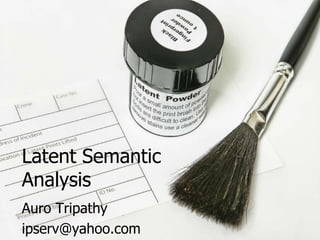
Latent Semanctic Analysis Auro Tripathy
- 2. Outline Introduction Singular Value Decomposition Dimensionality Reduction LSA in Information Retrieval
- 3. Latent Semantic Analysis Introduction
- 4. Mathematical treatment capable of inferring meaning Measures of word-word, word-passage, & passage-passage relations that correlate well with human understanding of semantic similarity Similarity estimates are NOT based on contiguity frequencies, co-occurrence counts, or usage correlations Mathematical way capable of inferring deeper relationships; hence “latent”
- 5. Akin to a well-read nun dispensing sex-advice Analysis of text alone Its knowledge does NOT come from perceived information about the physical world, NOT from instinct, NOT from feelings, NOT from emotions Does NOT take into account word-order, phrases, syntactic relationships, logic, It takes in large amounts of text and looks for mutual interdependencies in the text
- 6. Words and Passages LSA represents the meaning of a word as the average of the meaning of all the passages in which it appears… …and the meaning of the passage as an average of the meaning of the words it contains word1 word2 word3
- 7. What is LSA? LSA is a mathematical technique for extracting and inferring relations of expected contextual usage of words in documents
- 8. What LSA is not Not a natural language processing program Not an artificial intelligence program Does NOT use dictionaries or databases Does NOT use syntactic parsers Does not use morphologies Takes as input – words and text paragraphs
- 9. Example Titles of N=9 technical memoranda Five on human-computer interaction Four on mathematical graph theory Disjoint topics Source: An Introduction to Latent Semantic Analysis, Landauer, Foltz, Laham
- 10. Sample Word-by-Document Matrix Word selection criteria – occurs in at least two of the titles How much was said about a topic Source: An Introduction to Latent Semantic Analysis, Landauer, Foltz, Laham
- 11. Semantic Similarity using Spearman rank coefficient correlation The correlation between human and user is negative, -0.38 The correlation between human and minor is also negative, -0.29 Expected; words never in the same passage, no co-occurrences Spearman ρ (human.user) = -0.38 Spearman ρ (human.minor) = -0.29 http://en.wikipedia.org/wiki/Spearman's_rank_correlation_coefficient
- 13. The Term Space Documents Terms Source: Latent Semantic Indexing and Information Retrieval, Johanna Geiß
- 14. The Document Space Documents Terms Source: Latent Semantic Indexing and Information Retrieval, Johanna Geiß
- 15. The Semantic Space one space for terms and documents Represent terms AND documents in one space Makes it possible to calculate similarities Between documents Between terms Between terms and documents
- 16. The Decomposition Term1 Term2 Term3 S DT M T Term-by- rxr rxd document matrix txd txr Splits the term-document matrix into three matrices New space, the SVD space because new axes were found by SVD along which the terms and documents can be grouped
- 17. New Term Vector, New Document Vector, & Singular Values T contains in its rows the term vectors scaled to a new basis DT contains the new vectors of the documents S contains the singular values σ1,σ2, …. σn Where, σ1 ≥ σ2 ≥ …. ≥ σn ≥ 0
- 18. Dimensionality Reduction To reveal the latent semantic structure
- 19. Reduce to k Dimensions Term1 Term2 S DT Term3 M T Term-by- kxk rxk document matrix txd txk
- 20. Example Term Vector Reduced to two Dimensions T S D Source: An Introduction to Latent Semantic Analysis, Landauer, Foltz, Laham
- 21. Reconstruction of the original matrix based on the reduced dimensions NEW Original Source: An Introduction to Latent Semantic Analysis, Landauer, Foltz, Laham
- 22. Recomputed Semantic Similarity using Spearman rank coefficient correlation Spearman ρ (human.user) = +0.94 NEW Spearman ρ (human.minor) = -0.83 Spearman ρ (human.user) = -0.38 Original Spearman ρ (human.minor) = -0.29 Humans-user correlation went up and the human-minor correlation went down
- 23. Correlation between a title and all other titles – Raw Data •Correlation between the human-computer interaction titles was low •Average correlations, 0.2; half the Spearman correlations were 0 •Correlation between the four graph-theory papers (mx / my) was mixed •Average Spearman correlation was 0.44, 0. •Correlation between human-computer interaction titles and the graph-theory papers was -0.3, despite no semantic overlap Source: An Introduction to Latent Semantic Analysis, Landauer, Foltz, Laham
- 24. Correlation in the reduced dimension (k=2) space •Average correlations jumped from 0.2 to 0.92 •Correlation between the graph-theory papers (mx/my) was HIGH;1.0 •Correlation between human-computer interaction titles and the graph-theory papers was strongly negative Source: An Introduction to Latent Semantic Analysis, Landauer, Foltz, Laham
- 25. LSA in Information Retrieval
- 26. How to treat a query Matrix of term-by-document Perform SVD, reduce dimensions to 50-400 A query is a “pseudo-document” Weighted average of the vector of the words it contains Use a similarity metric (such as cosine) between the query vector and the document- to-document vectors Rank the results
- 27. The Query Vector Does better that literal matches between terms in query documents Superior when query and document use different words Source: Latent Semantic Indexing and Information Retrieval, Johanna Geiß
- 28. References • Latent Semantic Indexing and Information Retrieval, Johanna Geiß • An Introduction to Latent Semantic Analysis, Landauer, Foltz, Laham
